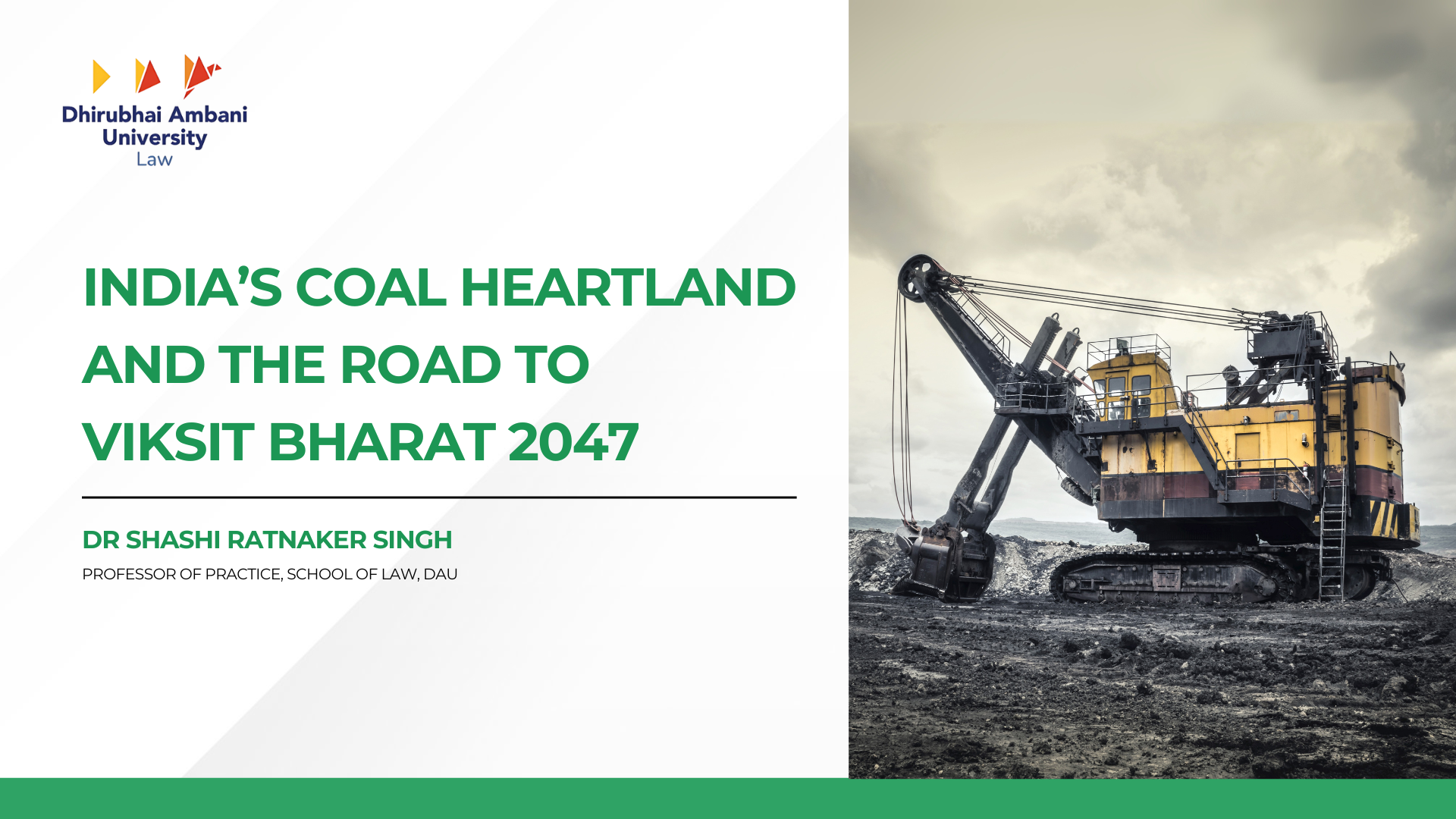By Dr Shashi Ratnaker Singh
Professor of Practice, Dhirubhai Ambani University – School of Law

India, the world’s fourth-fastest growing economy, stands at a crucial intersection. The dual challenges of development and decarbonisation are central to India’s political economy. As the nation aspires to uplift over 1.4 billion citizens and position itself as a global power, it must do so while navigating the climate emergency that is no longer distant—it is here, and it is urgent.
The recurring heatwaves, extreme rainfall and cloud burst in the hilly states are not isolated incidents; they are signalling that climate disruption is now a lived reality. The question is: how can India sustain economic growth while advancing toward its climate commitments? This dilemma is particularly acute in the context of the country’s coal-bearing regions, which have historically powered the economy but now face the brunt of energy transition pressures. The coal bearing states in the central and eastern India have been categorised by the Ministry of New and Renewable Energy as ‘Variable Renewable Energy Poor’, which broadly indicates that these states will have relatively less RE generation potential as compared to the Southern and Western States. And therefore, from federal perspective, it becomes important to assess the costs and benefits of energy transition and how this can be equitably shared among the states.
Energy Transition and the Coal Equation
India is the world’s third-largest consumer of fossil fuels, and coal continues to dominate the country’s energy mix, contributing roughly 55% of total energy and 74% of domestic electricity production. The fiscal year 2024–25 marked a milestone as India crossed the 1 billion tonne coal production threshold—a 5% increase over the previous year. This milestone came with substantial gains: reduced coal imports by 8.5%, forex savings of ₹42,315 crore, and revenue contributions exceeding ₹70,000 crore.
Coal also sustains over 2.4 lakh formal jobs through Coal India Limited and supports millions more indirectly in the coal bearing districts. Despite India’s commendable renewable energy (RE) capacity—over 234 GW installed (242.8 GW non-fossil fuel-50.08% India’s clean energy achieved in July 2025 that is 5years ahead of its 2030 target), coal remains the critical base load provider. India plans to add another 90 GW of coal capacity by 2032, highlighting the complex interplay between meeting industrial demand and adopting cleaner energy technologies.
Just Transition Imperatives
But this production milestone is also a signal—it’s time to prepare for what comes next. The coal-bearing districts that have supported national development for decades must now be positioned for an inclusive and sustainable economic future.
Since 2015, District Mineral Foundations (DMFs) have addressed the immediate socio-economic needs of mining-affected communities. However, DMFs lack long-term vision—particularly around intergenerational justice. Models like the Alberta Heritage Fund or Alaska Permanent Fund show how early financial planning can prepare regions for post-extraction futures.
Coal-rich districts need more than short-term compensation. They need comprehensive policy packages—tax incentives, investment stimuli, and strategic repurposing of mining infrastructure. Currently, many of these regions—identified as Variable Renewable Energy (VRE) poor by the Ministry of New and Renewable Energy—lack both RE potential and RE manufacturing investments. None of the top 15 solar component manufacturing units are in these states or districts. This geographical disadvantage has left eastern and central India behind, while RE-related jobs and infrastructure flourish in the southern and western states. Currently, Gujarat, Rajasthan, Maharashtra, Karnataka and Tamil Nadu hosts country’s 65 % of total RE installation, 74% of Solar and 62% of the Solar PV manufacturing plants (Source: MNRE, ALMM, July 2025). So roughly, 81% of the solar manufacturing capacity of the country comes from these 5 states. From the political economy perspective, the question emerges, that if the Central and Eastern states have relatively lesser RE generation potential as compared to Western and Southern states, shouldn’t they be empowered with RE manufacturing investments to sustain their economic future. Of course, a larger economic transformation is needed for economic diversification and fossil fuel revenue substitution of these districts.
Federal Dynamics
Roughly 77% of India’s coal reserves are concentrated in 35 districts of Madhya Pradesh, Chhattisgarh, Jharkhand, and Odisha—states that have long fuelled national growth but remain economically fragile. Many of their coal districts rank high on the multidimensional poverty index as per Niti Aayog and are home to large Adivasi populations. These regions are economically dependent on coal and deserve procedural and distributive justice in the energy transition.
These districts cannot be expected to undergo an “energy-to-energy” transition alone. Instead, the shift must be systemic. One promising idea is to transform these areas into Special Economic Zones (SEZs) with a focus on green industrialisation, not just energy. India’s 2005 SEZ policy largely benefited IT sectors, but the potential for manufacturing-led growth—especially in post-mining zones—remains untapped.
Repurposing unused mining land for environmentally and socially aligned industries can create sustainable jobs, reduce land acquisition pressures, and maintain local economic dynamism. Global examples abound, and India must tailor such transitions to its own context.
Managing Mine Closures and Skill Transition
India must also prepare for the lifecycle end of coal mines and thermal power plants. Decommissioning offers valuable lessons but India needs to craft its own pathway. It impacts local ecosystems, public health, employment, and land use. Frameworks like the Coal Bearing Act, Mining Closure Guidelines, RFCTLARR and Forest Conservation Act already offer regulatory scaffolding, but they need clearer implementation pathways focused on repurposing land for public good.
New skills must be cultivated to support emerging sectors. A smooth employment transition requires retraining and education tailored to regional strengths—not just green energy but broader manufacturing, logistics, and services.
Justice Across Scales
India’s energy transition must be seen through multiple justice lenses: global (developed vs. developing countries), national (wealthy vs. poor regions), social (rich vs. poor communities), and generational (current vs. future citizens). Per capita emissions don’t capture these nuances; policy must instead recognise differentiated responsibilities and capacities within Indian society.
Just transition is no longer a theoretical ideal. States like Jharkhand have already formed dedicated Just Transition Task Force. Others must follow suit, integrating social safeguards, revenue substitution models, and regional industrial strategies into broader state development plans.
Financing the Transition
Climate finance will be critical. Domestic funding windows through CSR, CAMPA, and DMF, are more in control and dependable sources. The last 10 years of CSR and DMF collections have shown impressive contribution of approx 17 billion and 11 billion USD respectively. The existing challenges remains with the 56% unspent DMF funds. These channels remain underutilised. Unlocking their potential, alongside mechanisms like environmental fiscal transfers and blended finance, can catalyse regional transition plans. The 16th Finance Commission could play a transformative role by aligning transfers with climate and environmental performance. International finance must also play its part. The Indian government’s taxonomy for climate finance, once detailed, could bring focussed interventions. Linking it to sectoral policies will further embed just transition into the national development agenda.
The Road Ahead
India’s 2070 net zero target is the larger backdrop. But the pathway to Viksit Bharat 2047—the vision of a developed, inclusive India—depends on how the country manages its energy shift today.
For this, state governments must be empowered as transition architects. They are best placed to lead stakeholder engagement, land-use planning, and region-specific economic diversification. Planning for this transition is not a distant priority—it is a present necessity.
India’s coal-bearing districts have long powered the nation’s rise. Now, they must be empowered to reimagine their own future- as ‘Viksit Districts for Viksit Bharat’.
